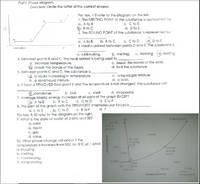
College Physics
11th Edition
ISBN: 9781305952300
Author: Raymond A. Serway, Chris Vuille
Publisher: Cengage Learning
expand_more
expand_more
format_list_bulleted
Question
thumb_up100%

Transcribed Image Text:Part I. Phase diagram.
Direction: Circle the letter of the corect answer.
For nos. 1-8 refer to the diagram on the left.
1. The MELTING POINT o1 the substance is representec by
a. A to B
b. B to C
2. The BOILING POINT of the substance is represented by
c. C to D
d. Dto E
(d, D to E
c. C to D
3. Heat is added between points D and E. The substance is
а. A lo B b. B to C
Ieat dded
a. sublimating
b. meiting c. freezing a boling
4. Between points B and C, the heal added is being used lo
a. increase temperature.
break the bonds of the liquid.
5. Between points C and D, the substance is
O a liquid increasing in temperature.
b. a solid/liquid mixture.
6. If heat is REMOVED from point E and Ihe temperature is not changed, the substance will
c. break the bonds of the solid.
d. boil the substance.
C. a liquid/gas mixture.
d. a soid.
6 condense
b. boil
c. melt
d. evaporate
7. Average kinetic energy increases at ail parts of the graph EXCEPT
a A to B
8. The part of the graph with the STRONGEST intermolecular torces is
a. A to B b C to D C. E to F
For nos. 9-10 reter to the diagram on the right.
9. What is the state of water at 2 atm and 50?
a. solid
b. liquid
C. gas
d. none
10. What phase change will occur if the
temporature is lowered from 80C to -5-C al 1 atm?
a. Iroozing
b. meling
c. condensing
d. evaporating
b. B to C
c. C to D
d. E to F
d. F
Critical point
217.75
Critical
pressure
Liquid
Normal
freezing
point
1.00
Normal
boiling
point
Solid
IA
0.0060
Triple
Vapor
point
100 00
373.99
0.00 0.01
Critical
Temperature (O
temperature
Pressure (atm)
Expert Solution
This question has been solved!
Explore an expertly crafted, step-by-step solution for a thorough understanding of key concepts.
This is a popular solution
Trending nowThis is a popular solution!
Step by stepSolved in 2 steps with 3 images

Knowledge Booster
Learn more about
Need a deep-dive on the concept behind this application? Look no further. Learn more about this topic, physics and related others by exploring similar questions and additional content below.Similar questions
- 1,2,3arrow_forwardProblems: Show all work for full credit 1. A) Calculate the electrical force acting on charge B (magnitude & direction) Qa = 9 x 10 °C Qb = 18 x 10 °C Iab = 0.05 m B) If Qa is removed and replaced with a charge of Qc = - 4.2 x 10 °C at the same position, describe how the force on charge B would change (magnitude & direction). [Do not do math, just use words] The force would because The direction would be becausearrow_forward
arrow_back_ios
arrow_forward_ios
Recommended textbooks for you
 College PhysicsPhysicsISBN:9781305952300Author:Raymond A. Serway, Chris VuillePublisher:Cengage Learning
College PhysicsPhysicsISBN:9781305952300Author:Raymond A. Serway, Chris VuillePublisher:Cengage Learning University Physics (14th Edition)PhysicsISBN:9780133969290Author:Hugh D. Young, Roger A. FreedmanPublisher:PEARSON
University Physics (14th Edition)PhysicsISBN:9780133969290Author:Hugh D. Young, Roger A. FreedmanPublisher:PEARSON Introduction To Quantum MechanicsPhysicsISBN:9781107189638Author:Griffiths, David J., Schroeter, Darrell F.Publisher:Cambridge University Press
Introduction To Quantum MechanicsPhysicsISBN:9781107189638Author:Griffiths, David J., Schroeter, Darrell F.Publisher:Cambridge University Press Physics for Scientists and EngineersPhysicsISBN:9781337553278Author:Raymond A. Serway, John W. JewettPublisher:Cengage Learning
Physics for Scientists and EngineersPhysicsISBN:9781337553278Author:Raymond A. Serway, John W. JewettPublisher:Cengage Learning Lecture- Tutorials for Introductory AstronomyPhysicsISBN:9780321820464Author:Edward E. Prather, Tim P. Slater, Jeff P. Adams, Gina BrissendenPublisher:Addison-Wesley
Lecture- Tutorials for Introductory AstronomyPhysicsISBN:9780321820464Author:Edward E. Prather, Tim P. Slater, Jeff P. Adams, Gina BrissendenPublisher:Addison-Wesley College Physics: A Strategic Approach (4th Editio...PhysicsISBN:9780134609034Author:Randall D. Knight (Professor Emeritus), Brian Jones, Stuart FieldPublisher:PEARSON
College Physics: A Strategic Approach (4th Editio...PhysicsISBN:9780134609034Author:Randall D. Knight (Professor Emeritus), Brian Jones, Stuart FieldPublisher:PEARSON

College Physics
Physics
ISBN:9781305952300
Author:Raymond A. Serway, Chris Vuille
Publisher:Cengage Learning

University Physics (14th Edition)
Physics
ISBN:9780133969290
Author:Hugh D. Young, Roger A. Freedman
Publisher:PEARSON

Introduction To Quantum Mechanics
Physics
ISBN:9781107189638
Author:Griffiths, David J., Schroeter, Darrell F.
Publisher:Cambridge University Press

Physics for Scientists and Engineers
Physics
ISBN:9781337553278
Author:Raymond A. Serway, John W. Jewett
Publisher:Cengage Learning

Lecture- Tutorials for Introductory Astronomy
Physics
ISBN:9780321820464
Author:Edward E. Prather, Tim P. Slater, Jeff P. Adams, Gina Brissenden
Publisher:Addison-Wesley

College Physics: A Strategic Approach (4th Editio...
Physics
ISBN:9780134609034
Author:Randall D. Knight (Professor Emeritus), Brian Jones, Stuart Field
Publisher:PEARSON